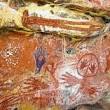Exploring the Timeless Beauty of Indigenous Art
The Richness of Indigenous Art
Indigenous art is a vibrant and diverse form of artistic expression that reflects the cultural heritage and traditions of indigenous communities around the world. From intricate beadwork to bold paintings, indigenous art encompasses a wide range of styles and techniques that have been passed down through generations.
One of the defining features of indigenous art is its deep connection to the natural world. Many indigenous artists draw inspiration from their surroundings, incorporating elements of the land, animals, and plants into their work. This close relationship with nature not only informs the aesthetic qualities of indigenous art but also carries important spiritual and symbolic meanings.
Moreover, indigenous art often serves as a means of preserving and sharing traditional knowledge and stories. Through intricate patterns, symbols, and motifs, artists convey narratives that have been handed down orally for centuries. These artworks act as visual representations of cultural identity and serve as a powerful tool for storytelling and education.
Despite facing challenges such as cultural appropriation and marginalisation, indigenous art continues to thrive and evolve. Many contemporary indigenous artists are finding new ways to blend traditional techniques with modern influences, creating innovative works that resonate with audiences around the globe.
By appreciating and supporting indigenous art, we not only celebrate the creativity and talent of these artists but also honour their rich cultural heritage. Through their unique perspectives and artistic expressions, indigenous artists offer us a glimpse into their worldviews, traditions, and values.
Let us embrace the richness and diversity of indigenous art as a testament to the enduring spirit and resilience of indigenous communities worldwide.
Exploring Indigenous Art: Understanding Its Characteristics, Cultural Heritage, Evolution, and Significance
- What is indigenous art?
- What are the characteristics of indigenous art?
- How does indigenous art reflect cultural heritage?
- What materials are commonly used in indigenous art?
- How has indigenous art evolved over time?
- What is the significance of storytelling in indigenous art?
- How can one support and appreciate indigenous art?
What is indigenous art?
Indigenous art encompasses a diverse range of artistic expressions created by indigenous communities worldwide. It reflects the cultural heritage, traditions, and spiritual beliefs of these communities, often drawing inspiration from the natural world and ancestral knowledge. Indigenous art serves as a powerful medium for storytelling, preserving cultural identity, and sharing important narratives that have been passed down through generations. Through intricate patterns, symbols, and motifs, indigenous artists convey unique perspectives and values that offer insight into their rich histories and ongoing struggles for recognition and preservation.
What are the characteristics of indigenous art?
Indigenous art is characterised by its deep-rooted connection to cultural heritage and traditions, reflecting the unique identities of indigenous communities worldwide. One of the key characteristics of indigenous art is its emphasis on storytelling, with intricate patterns, symbols, and motifs often used to convey narratives that have been passed down through generations. Additionally, indigenous art frequently incorporates elements of the natural world, drawing inspiration from the land, animals, and plants that hold significant spiritual and symbolic meanings. These artworks not only serve as visual representations of cultural identity but also act as a means of preserving traditional knowledge and sharing important stories with future generations. The diversity and richness of indigenous art showcase the creativity, resilience, and profound cultural significance of indigenous peoples across different regions and communities.
How does indigenous art reflect cultural heritage?
Indigenous art serves as a powerful reflection of cultural heritage through its intricate symbols, patterns, and storytelling techniques. Each brushstroke or beadwork design carries deep-rooted meanings and connections to the traditions, beliefs, and values of indigenous communities. By incorporating elements from nature, ancestral wisdom, and historical narratives into their art, indigenous artists not only preserve their cultural identity but also pass down important knowledge to future generations. The vibrant colours and unique styles found in indigenous art are a testament to the rich tapestry of diverse cultures that have shaped these artistic traditions over centuries.
What materials are commonly used in indigenous art?
In indigenous art, a diverse array of materials is commonly employed to create unique and culturally significant artworks. From natural resources like wood, stone, clay, and animal hides to more modern mediums such as acrylic paints and canvas, indigenous artists utilise a wide range of materials to bring their creative visions to life. Each material carries its own symbolic meanings and cultural significance, reflecting the deep connection between the art form and the traditions of indigenous communities. By carefully selecting and working with these materials, artists infuse their creations with a sense of history, spirituality, and respect for the natural world.
How has indigenous art evolved over time?
Indigenous art has undergone a fascinating evolution over time, reflecting the changing dynamics of indigenous cultures and their interactions with the wider world. From ancient rock paintings to contemporary multimedia installations, indigenous art has adapted and transformed in response to historical events, social shifts, and cultural exchanges. While traditional techniques and motifs remain integral to many indigenous artworks, artists have also embraced innovation and experimentation, incorporating new materials and technologies into their practice. This blending of old and new elements has resulted in a diverse and dynamic landscape of indigenous art that continues to evolve, challenge perceptions, and resonate with audiences globally.
What is the significance of storytelling in indigenous art?
Storytelling holds immense significance in indigenous art as it serves as a powerful means of preserving and transmitting cultural knowledge, traditions, and values from one generation to the next. Through intricate symbols, motifs, and narratives depicted in their artwork, indigenous artists convey stories that are deeply rooted in their heritage and connection to the land. These stories not only educate and entertain but also carry spiritual and symbolic meanings that reflect the worldview and beliefs of indigenous communities. By incorporating storytelling into their art, indigenous artists ensure that their rich cultural histories remain alive and relevant, fostering a sense of identity, pride, and continuity within their communities.
How can one support and appreciate indigenous art?
To support and appreciate indigenous art, one can start by actively seeking out and purchasing artworks directly from indigenous artists and communities. By buying authentic pieces, individuals can contribute to the economic empowerment of indigenous creators and help sustain their cultural practices. Additionally, attending exhibitions, workshops, and events that showcase indigenous art is a great way to learn more about the diverse traditions and stories behind the artworks. It is important to approach indigenous art with respect, understanding its cultural significance and historical context. Sharing information about indigenous artists and their work with others can also help raise awareness and promote greater recognition of their contributions to the art world.


